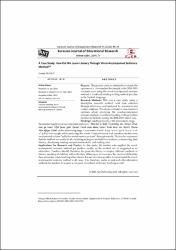A Case Study: How Did We Learn Literacy Through Word-Accompanied Sentence Method?
Abstract
Purpose: The present study is intended to evaluate the opinions of a class teacher that taught in the 2018-2019 academic year using the word-accompanied sentence method, a combined reading-writing method peculiar to the Turkish language.
Research Methods: This was a case study using a descriptive research method, with data collected through interviews and analyzed by document and content analyses. This study evaluates a class teacher's opinions about practicing the word-accompanied sentence method; a combined reading-writing method peculiar to Turkish, during the 2018-2019 school year.
Findings: Teaching vowels at the preparatory stage, the teacher taught word-accompanied sentences "Alim bal al. (bal). Talat kitap oku. (kitap). Omer misir ye. (misir). Ufuk fener getir. (fener). Cemil cicek ekmis. (cicek). Evde uzum var. (uzum). Hasan Jale agliyor (Jale)" at the structuring stage. Consonants (l-m-b * k-t-p * y-r-s * g-f-n * s-c-c * v-d-z * g-h-j) were taught while analyzing the words. Comprehension and narration studies were incorporated to form "syllables-words-sentences-texts" through sounds. The teacher expressed that the method was useful to all, including arefugees and inclusive students, in improving their literacy, developing reading comprehension skills, and reading rates.
Implications for Research and Practice: In this study, the teacher who applied the word-accompanied sentence method got positive results, so the method can be suggested as an alternative. Teachers should, therefore, be given the liberty to employ different methods in literacy teaching of children with individual differences, to overcome the practical difficulties they encounter, when teaching other classes. It is not of course possible to recommend the word-accompanied sentence method to all cases. It is, therefore, useful to seek and offer alternative methods for teachers to acquire a rich pool of methods in literacy teaching as well.


















